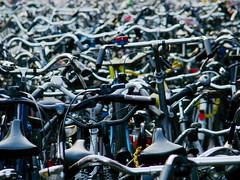What is so special about a cronky old granny's bike? A timeless beauty might be a more respectful way of describing the traditional Dutch bicycle (TDB). It is a design classic, an integral part of the Dutch landscape, a machine perfectly suited to its environment and to the function it has to perform.
Still looks like an old-fashioned granny's bike . . .Darling, the retro-chic styling is the very thing that makes the TDB the most fashionable thing to be seen on. The Dutch call them omafiets, which means . . . grandma's bicycle - but more as a statement of fact than derision. They are solid, well made and last a lifetime. Many of the woman you see spinning around Amsterdam are literally riding their granny's bicycle.
How would you recognise a TDB? In the Netherlands, it is impossible to avoid them, but one has to be discerning to spot a true classic. A genuine TDB should have all of the following: a sexy hooped frame; a covered chain guard; a built-in lighting and locking system; saddlebags that John Wayne would have been proud of; stern upright handlebars; a back-rack large enough to carry a friend; and, most important of all, it must be completely black.
Any other distinguishing features? They have only one gear, a backpedalling brake system and they weigh a ton.
Sounds jolly uncomfortable. On the contrary, once you get going, the "roof inspector" position of the saddle and the sheer momentum give a very smooth ride; and back-pedalling brakes are, apparently, great for developing the buttock muscles.
But why are the bikes peculiar to the Netherlands? In terms of bicycle evolution, Holland is the Galapagos Islands; there is no real need to change. The Safety Bicycle introduced by John Kemp Starley in 1884 became the standard model for the domestic Dutch cycle companies setting up at the turn of the century. This standard model was then free to roam on the extensive cycle network established in 1924. In this cycle-friendly environment, sales grew steadily, so that nowadays there are 2.5 bicycles per person in the Netherlands. There have been some flirtations with hybrids and even a few mountain-bike sales, but a slightly modified TDB is still the top seller.
So how do you get your hands on one of these galleons of the cycle lane?
They are three ways:
1 Buy new from a Dutch bicycle shop. There are four firms that still make the TDB's: Gazelle (supplier to the Dutch royal family), Union, Spartan and Batavus. Telephone or visit one of their official dealers - there are lots in Amsterdam. Beware of new foreign imitations, with unmanly names such as Nostalgie. They look the part from a distance, but they have none of the original's fine qualities or staying power.
2 Buy one secondhand from a cycle shop. The Dutch government has introduced a tax incentive whereby you can cheaply lease a new bike and trade it every three years. As a result, there is a very healthy secondhand market. You can pick up a used TDB for between € 50 and € 100
3 Hang around the dodgy areas by the central station until somebody hisses "Fietsen" (Dutch for bicycles). The bike will have been stolen and the seller will probably be a junkie . . . Not recommended.
Besides spending a lot of time with my webdesign agency FRUITWISH.nl i like to explore the web, and sometimes i write in this blog about common and un common things

